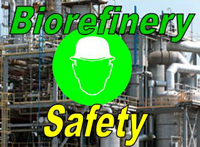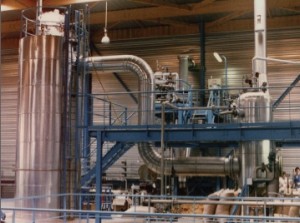 I’ve spent the last few weeks speaking with people in the biorefining industry in an effort to learn more about safety issues and best practices. The result is a series on Biorefinery Plant Safety and part one focuses on chemical safety. Chemicals are a necessary component of producing ethanol or biodiesel. On the ethanol side, some plants use chlorine dioxide or sulfuric acid in various aspects of the process – both in fermentation (to kill infections) and as a cleaning agent. On the biodiesel side, methanol is a commonly used.
I’ve spent the last few weeks speaking with people in the biorefining industry in an effort to learn more about safety issues and best practices. The result is a series on Biorefinery Plant Safety and part one focuses on chemical safety. Chemicals are a necessary component of producing ethanol or biodiesel. On the ethanol side, some plants use chlorine dioxide or sulfuric acid in various aspects of the process – both in fermentation (to kill infections) and as a cleaning agent. On the biodiesel side, methanol is a commonly used.
 Many things can happen when working with chemicals – slips, burns, fires, and explosions- and the biofuels industry has not been immune from any of these issues. While no one would tell me exactly what has caused some recent fires or explosions, I believe understanding cause and effect of mishandling chemicals/or properly handling chemicals, should reduce chemical accidents.
Many things can happen when working with chemicals – slips, burns, fires, and explosions- and the biofuels industry has not been immune from any of these issues. While no one would tell me exactly what has caused some recent fires or explosions, I believe understanding cause and effect of mishandling chemicals/or properly handling chemicals, should reduce chemical accidents.
To learn more, I spoke with Scott Berger, with the Center for Chemical Process Safety, formed by the American Institute of Chemical Engineers. Their goal is to improve guidelines and improve practices to prevent major chemical accidents such as fires, explosions and toxic gas release. Formed in 1985, they have published more than 100 guidelines with the work being done by their 140 plus members in the chemical, refining, biorefining, and other similar manufacturing businesses.
Berger noted that it doesn’t matter which chemical you decide to use in your facility, every material has a hazard. “If you don’t respect that hazard, don’t identify that hazard, don’t manage the hazard properly, then you can have a problem.”
What is the right way to communicate chemical safety? Berger said the first thing is that management has to recognize that they’re dealing with hazardous materials and then they have to commit that they are going to manage those hazards. He said because without that recognition and that commitment, nothing will happen. From there they need to implement a management system for managing the hazardous materials and the hazardous process.
Listen to my interview with Scott Berger here: Ethanol Safety Series Part I: How to Properly Handle Chemicals in a Biorefinery
Managing the hazards can involve many different steps but Berger said they should include knowing the hazards and knowing the skills you need to have to handle them properly so you can train people properly. A plan also needs to identify how the hazards manifest themselves in the process and come up with engineering solutions to address those hazards. But a plant must also have the right operating procedures and maintenance practices in place in order to operate safely. Lastly, said Berger, you have to look at your performance all along. If there are near misses that might be suggesting a problem coming in the future, and should be addressed before they can become more serious.
What is the best way to teach your employees about safety? While plants have various programs and training in place, one way is through an online training course. The Center for Chemical Process Safety received a grant from OSHA to develop on online training course for both ethanol and biodiesel plants. It is available for FREE for one more year. You can learn more about the course here. I highly recommend the entire industry go through the training – you can never be reminded of safety practices too many times.
So the key message? There are not two or three “best practice” tips for the industry, rather its a combination of practices that need to be put in to place and followed anytime you are working with or near a chemical.

